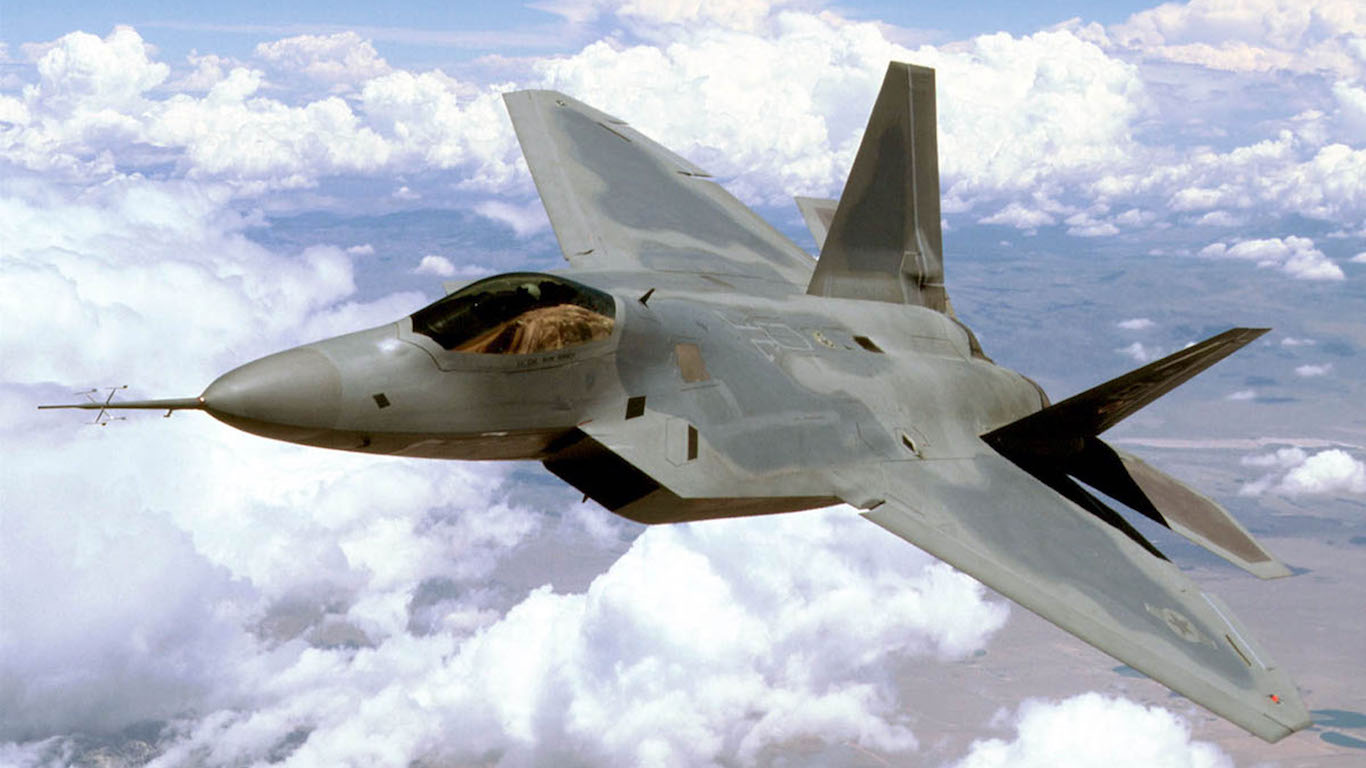
When most of us think of federal defense spending we envision fighter planes, tanks, battleships, and aircraft carriers. While some of the budget certainly goes to buy military armaments, in reality the majority is spent on salaries and benefits of military personnel, the Veterans Administration, and many other, more mundane, expenditures.
The House Appropriations Committee has already approved a $674.6 billion Department of Defense spending bill for fiscal year 2019. But as it remains under discussion in the Senate, it could change.
The approved budget is lower than the fiscal 2018 (October 2017 through September 2018) budget of $700 billion, which was approved last December and was $94 billion higher than the previous year budget. The 2019 budget is also lower than the proposed White House budget of $716 billion, which is more than half of all 2019 U.S. discretionary spending.
In addition to military warfighting equipment like tanks and ships and airplanes, the 2019 defense budget also includes a 2.6% pay hike for service personnel; an increase of 16,000 defense personnel to a total of 2.15 million; and $199 billion for the Department of Veterans Affairs.
The military acquisition budget totals $236.7 billion and includes $88.9 billion for overseas contingency operations (OCO) and global war on terror (GWOT) requirements. The House Appropriations Committee has approved $133 billion in equipment procurement for the 2019 fiscal year.
These $133 billion represent about 20% of the $674.6 billion defense budget, and about 3% of the total federal budget of $4.4 trillion, which includes mandatory spending of $2.74 trillion primarily on Social Security, Medicare, and Medicaid. The discretionary portion of the federal budget totals $1.3 trillion, and the rest ($363 billion) goes to pay interest on the national debt.
Under the House bill the U.S. Navy receives $22.7 billion to procure 12 ships. These include three guided missile destroyers, two Virginia-class submarines, three littoral combat ships (LCS), one expeditionary sea base, two fleet oilers, and one towing, rescue, and salvage ship.
The budget for the purchase of 93 F-35 Lightning II Joint Strike Fighters is $9.4 billion, and 24 F/A-18E/F will cost $1.9 billion. The Army gets $1.5 billion to upgrade 85 of its Abrams tanks.
The House bill also includes $34.4 billion for the Defense Department’s health program, including $364 million for cancer research, $125 million for research on psychological health and traumatic brain injuries, and $318 million directed at preventing and responding to sexual assault.
The entire Defense Department budget is a vast and specialized labyrinth that supports hundreds of thousands of civilian jobs in addition to the 1.34 million active duty personnel and 818,000 National Guard and Reserve troops. Here are the top 15 U.S. federal government and defense contractors ranked in order of federal funds obligated to each in 2017.
For company data, 24/7 Wall St. used annual reports filed for fiscal year 2017. Ranking of the companies is based on defense funding obligated in fiscal year 2017 as reported by the Federal Procurement Data System, a branch of the General Services Administration. Obligated funds in 2017 totaled $282.63 billion spread across 100 companies and included federal government purchases of everything from aircraft carriers to paper clips. Market cap is reported as of June 27, 2018.
Click here to see America’s 15 biggest defense contractors.
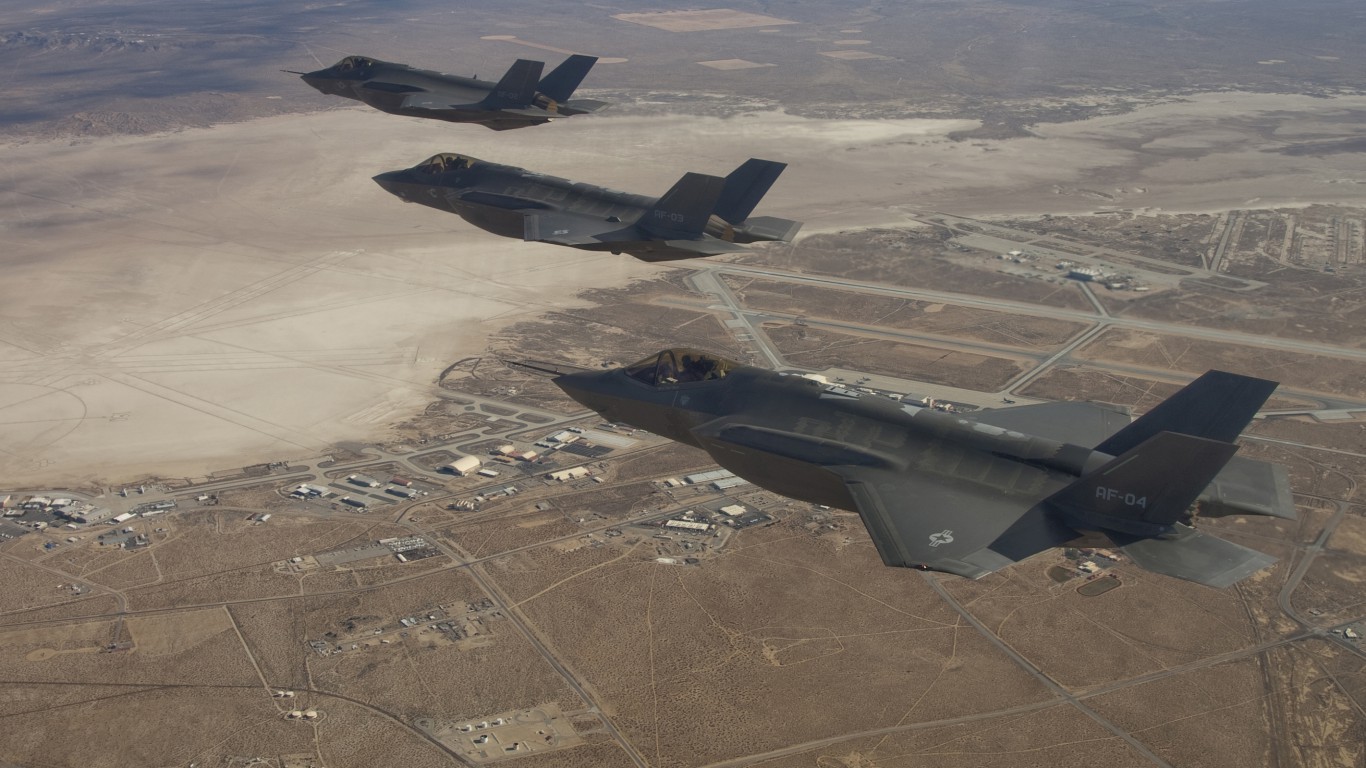
1. Lockheed Martin Corp. (NYSE: LMT)
> 2017 funding obligations: $50.70 billion
> Market cap: $85.15 billion
> Total revenue: $51.05 billion
> Net income: $2.00 billion
> Shares outstanding: 285.57 million
> Employees: approximately 100,000
Lockheed Martin is a pure-play defense contractor. The company builds and sells military aircraft, missiles, drones, fire control systems, helicopters, ships, and space systems. The government accounts for nearly all of Lockheed’s business, as the amount of federal funds obligated to the company accounted for nearly all of its full-year 2017 revenue. Lockheed captured nearly 18% of all federal procurement last year. The company’s headline program is the F-35 Lightning II Joint-Strike Fighter that is projected to haul in $1 trillion over its 60-year lifespan. For the current fiscal year, analysts forecast revenue of $51.33 billion and have a 12-month consensus price target on the stock of $371.89. Lockheed has cut some 26,000 employees since 2015.
[in-text-ad]
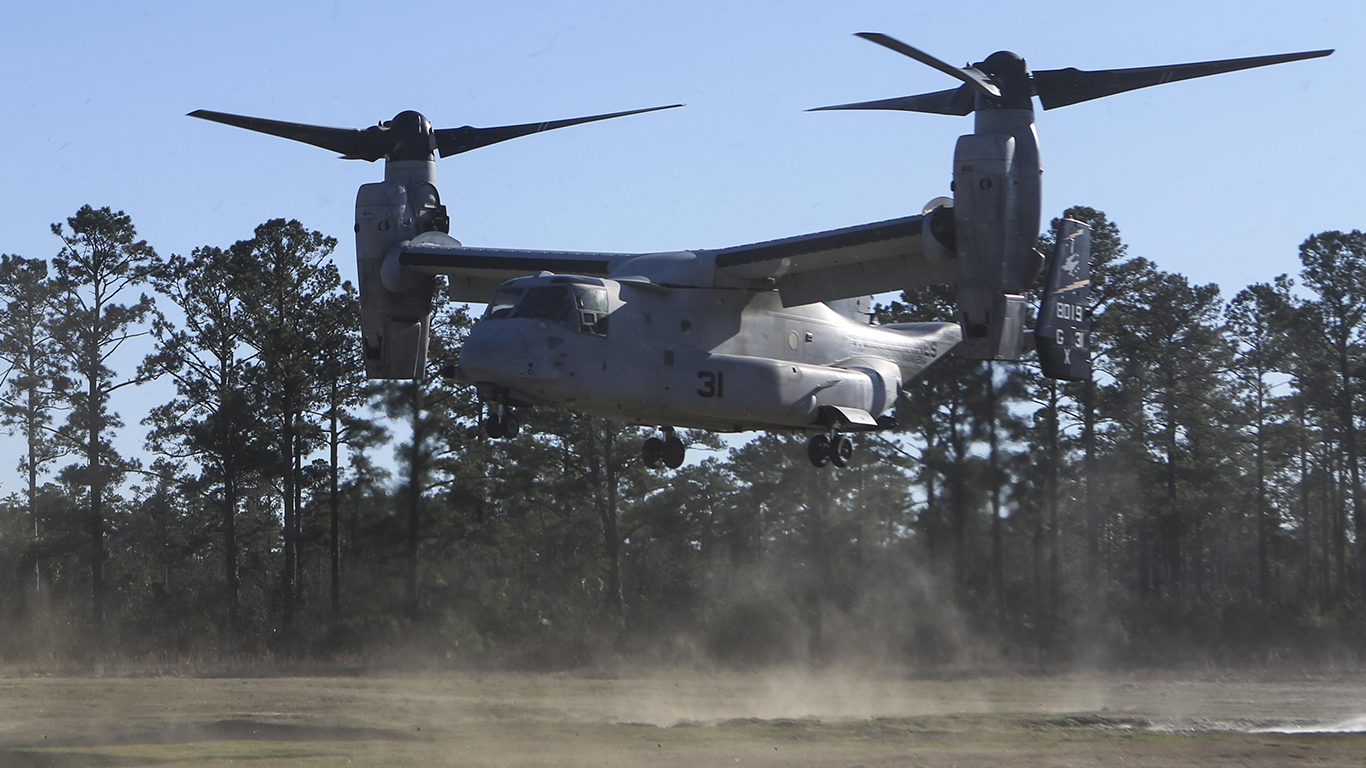
2. The Boeing Co. (NYSE: BA)
> 2017 funding obligations: $23.36 billion
> Market Cap: $194.29
> Total Revenue: $93.39 billion
> Net Income: $8.20 billion
> Shares outstanding: 588.45 million
> Employees: approximately 140,800
Military programs, including the KC-46A tanker, the F/A-18 Super Hornet, and Apache combat helicopter, accounted for more than $21 billion of Boeing’s fiscal year 2017 revenue, about 22% of the company’s total revenue. Like most of the other companies on this list, Boeing sells military systems internationally. The company expects $21.5 billion to $22.5 billion in military revenue for this year and has a backlog of $50 billion, 36% of which represents orders from foreign buyers. For the current fiscal year, analysts forecast revenue of $97.88 billion and have a 12-month consensus price target on the stock of $398.13.
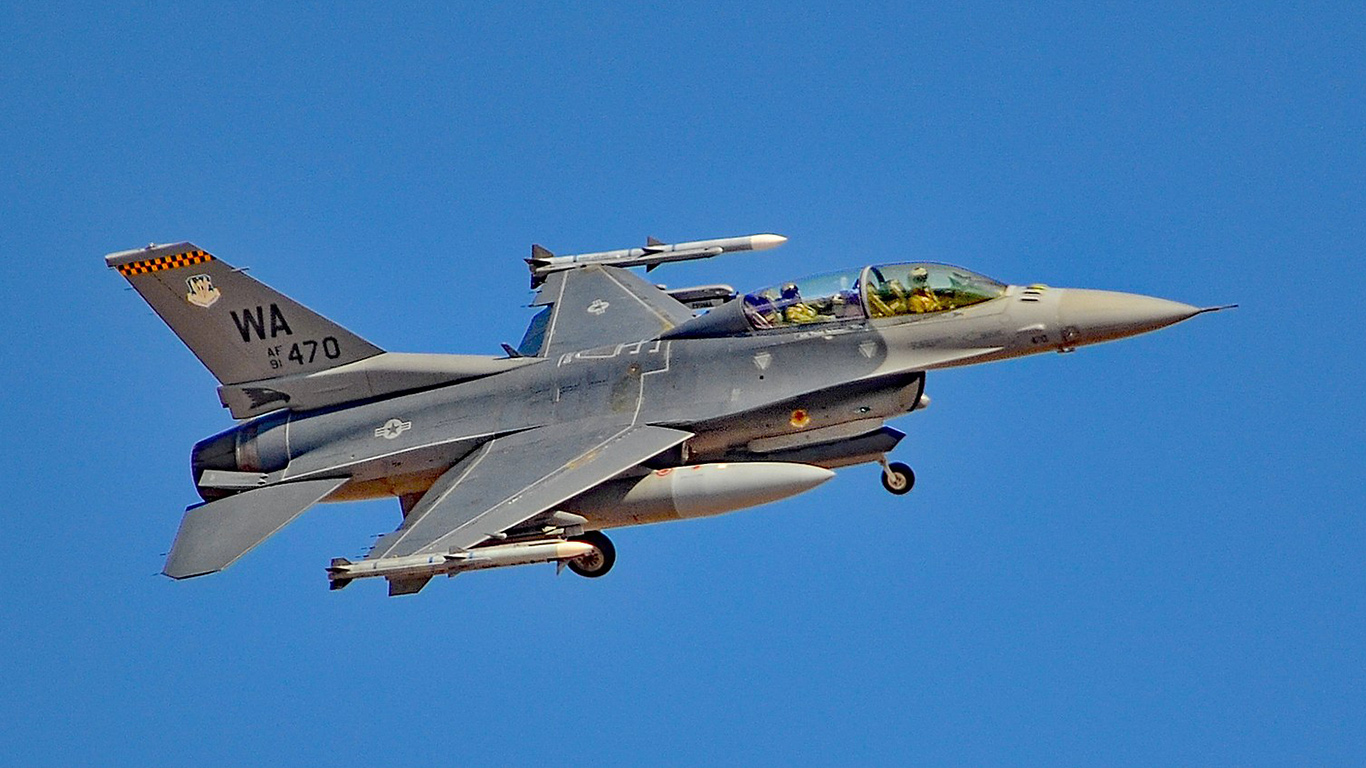
3. General Dynamics Corp. (NYSE: GD)
> 2017 funding obligations: $15.34 billion
> Market Cap: $55.80 billion
> Total Revenue: $30.97 billion
> Net Income: $9.56 billion
> Shares outstanding: 296.93 million
> Employees: 98,600
The poster child for General Dynamics is its Abrams main battle tank, but the company’s information systems and technology division accounted for the most revenue. To further bolster that part of the business, GD is paying $9.7 billion, including assumed debt, to acquire military IT specialist CSRA Inc. The deal will create the second largest provider of U.S. military IT services with annual sales of around $9.9 billion. As for those tanks, the company received a $1 billion contract from the U.S. government last year to upgrade 800 of them. For the current fiscal year, analysts forecast revenue of $35.94 billion and have a 12-month consensus price target on the stock of $247.53.
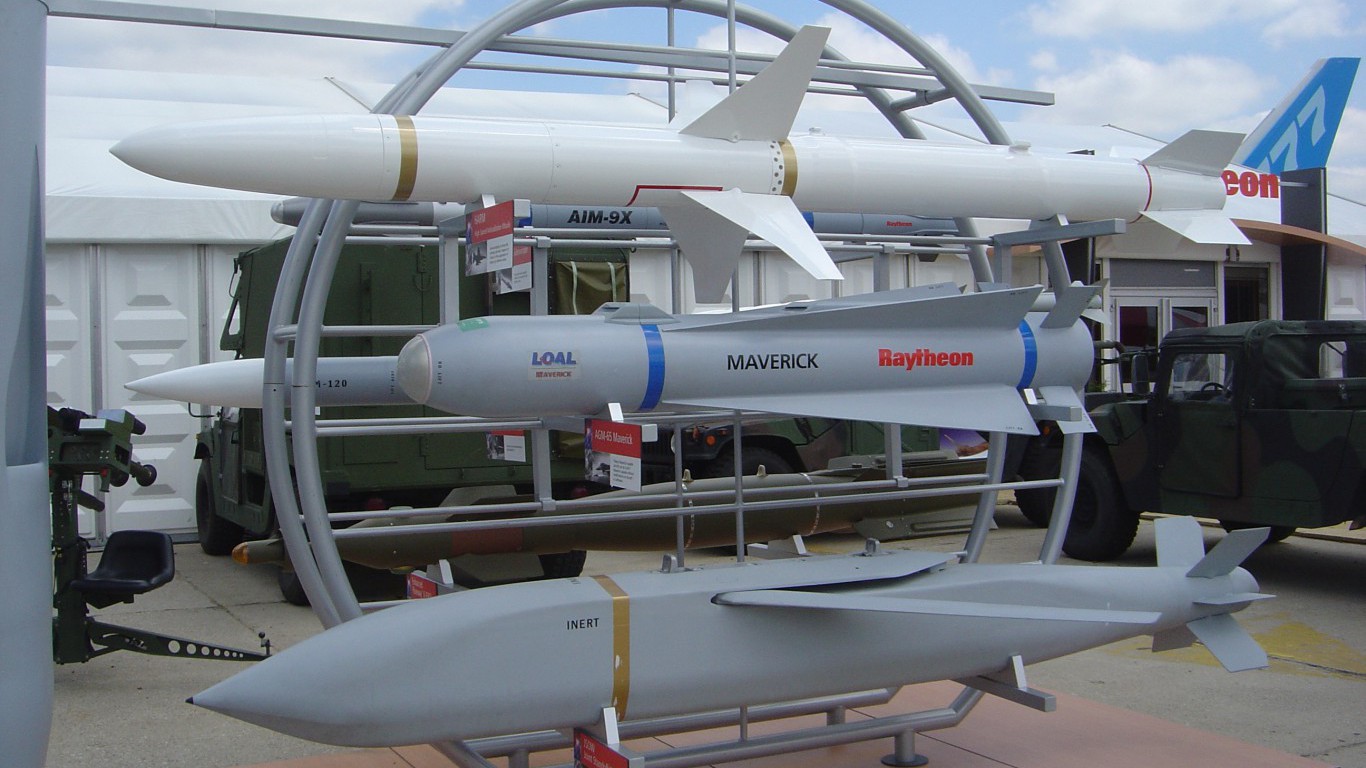
4. Raytheon Company (NYSE: RTN)
> 2017 funding obligations: $14.66 billion
> Market Cap: $56.18 billion
> Total Revenue: $25.35 billion
> Net Income: $2.00 billion
> Shares outstanding: 288.51 million
> Employees: approximately 64,000
Sales to the U.S. government accounted for two-thirds of Raytheon’s total 2017 revenue, and sales to foreign governments accounted for another 13%. The company’s largest division is missile systems, which brought in about $7.8 billion of last year’s revenue. Though there were rumors in the spring of 2017 that Boeing would acquire Raytheon, that did not happen. In addition to its missile business, Raytheon’s strengths include its radar, sensor, and guidance systems, and the company is focusing more on cybersecurity. Its Forcepoint cybersecurity joint venture with Vista Equity Partners racked up $608 million in revenue in 2017 and ended the year with a total backlog of $484 million. For the current fiscal year, analysts forecast revenue of $26.78 billion and have a 12-month consensus price target on the stock of $239.89.
[in-text-ad-2]
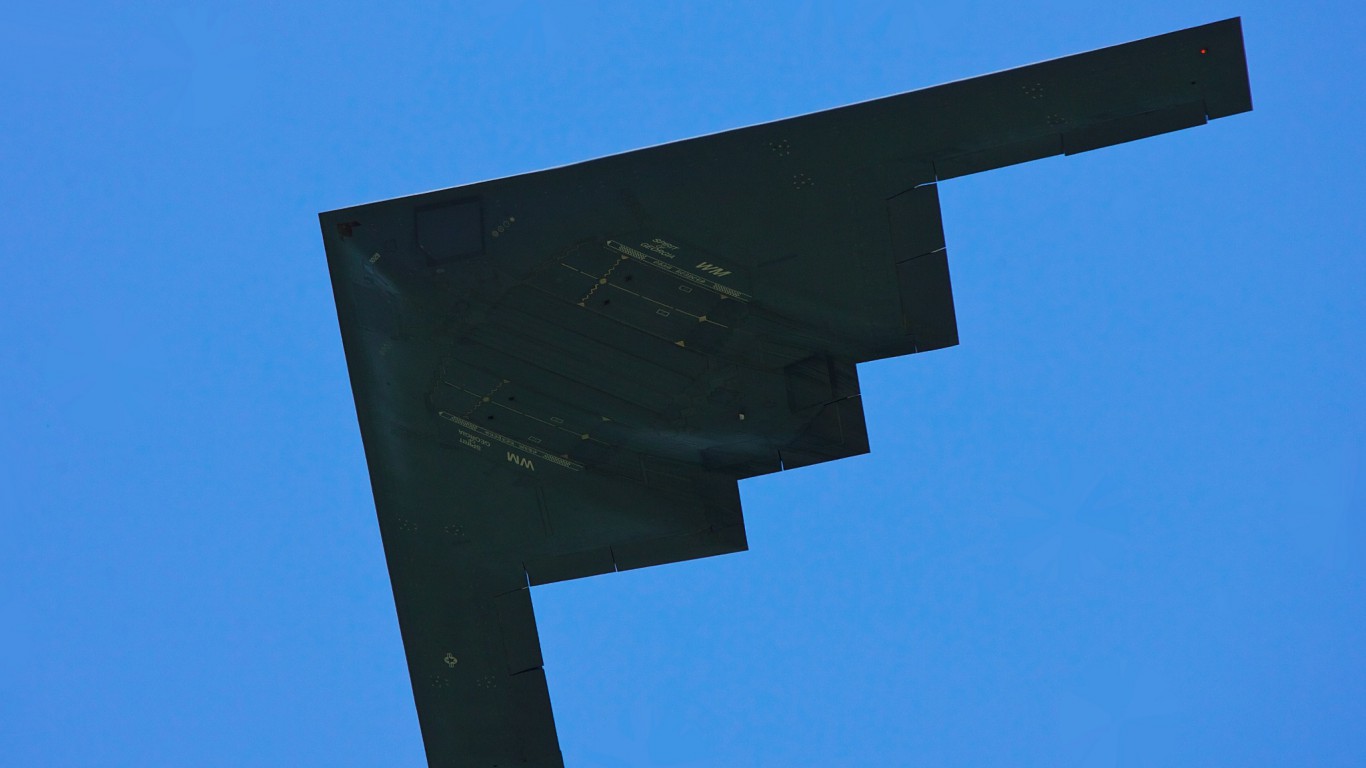
5. Northrop Grumman Corp. (NYSE: NOC)
> 2017 funding obligations: $11.19 billion
> Market Cap: $53.47 billion
> Total Revenue: $25.80 billion
> Net Income: $2.02 billion
> Shares outstanding: 174.09 million
> Employees: 70,000
Northrop Grumman operates in three main divisions: aerospace systems, mission systems, and technology services. The aerospace division manufactures and sells control systems for the F/A 18 (as a partner with Boeing), the B-2 bomber, and the venerable A-10 Warthog. Earlier this month, the company’s $9.2 billion acquisition of Orbital ATK, a maker of solid-fuel rocket engines, was approved by the Federal Trade Commission. Northrop was also awarded a $103 million contract to upgrade the wings on the A-10 ground-attack aircraft, which entered service in 1977. For the current fiscal year, analysts forecast revenue of $27.43 billion and have a 12-month consensus price target on the stock of $367.50.
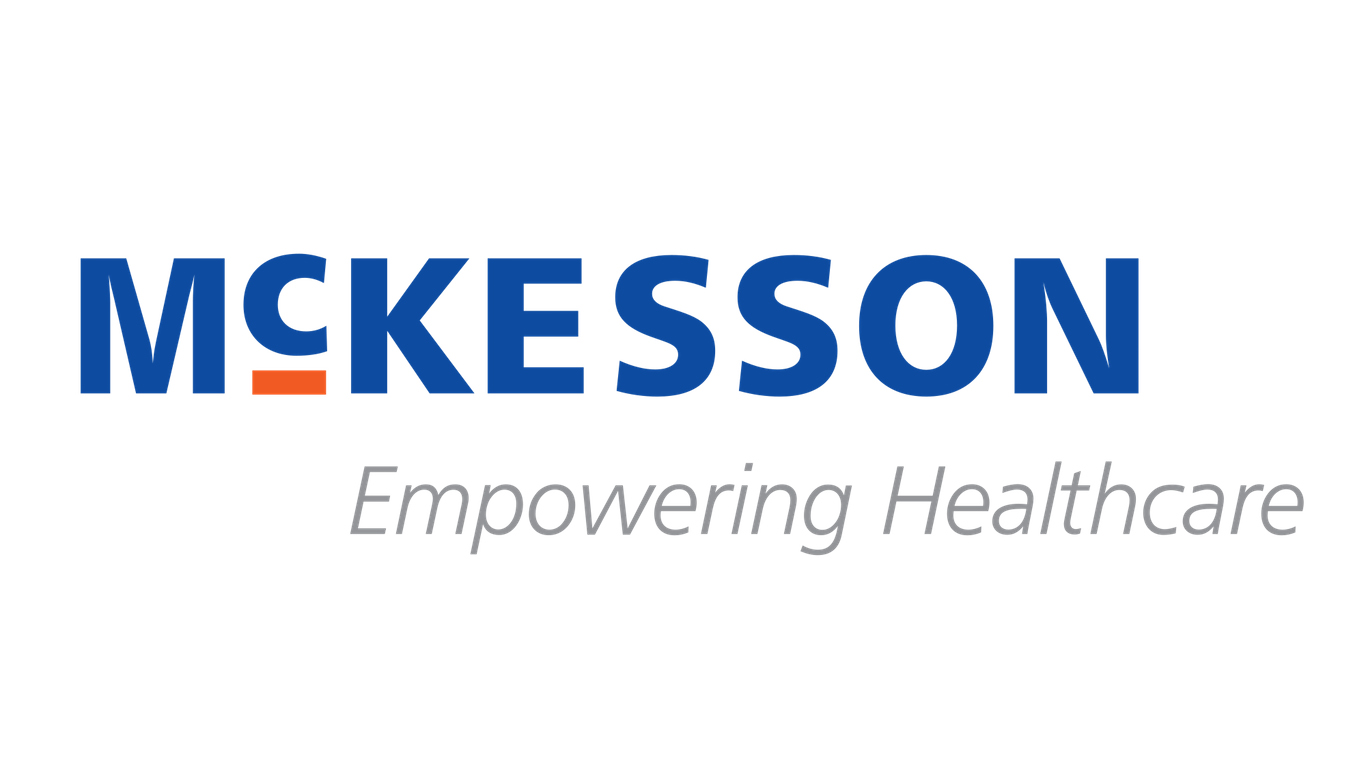
6. McKesson Corp. (NYSE: MCK)
> 2017 funding obligations: $8.80 billion
> Market Cap: $29.66 billion
> Total Revenue: $208.36 billion
> Net Income: $67 million
> Shares outstanding: 202.05 million
> Employees: 78,000
McKesson primarily distributes medical and pharmaceutical supplies for health care providers and pharmacies around the world. The company is the pharmaceutical prime vendor (PPV) for the Department of Veterans Affairs. Its current contract ends on August 9, and there is a two-year option remaining that the VA may exercise. The contract, originally awarded in 2012, has generated average annual revenue of around $4 billion and could generate a total of $44 billion if extended to 2020. For the current fiscal year, analysts forecast revenue of $216.15 billion and have a 12-month consensus price target on the stock of $171.60.
[in-text-ad]
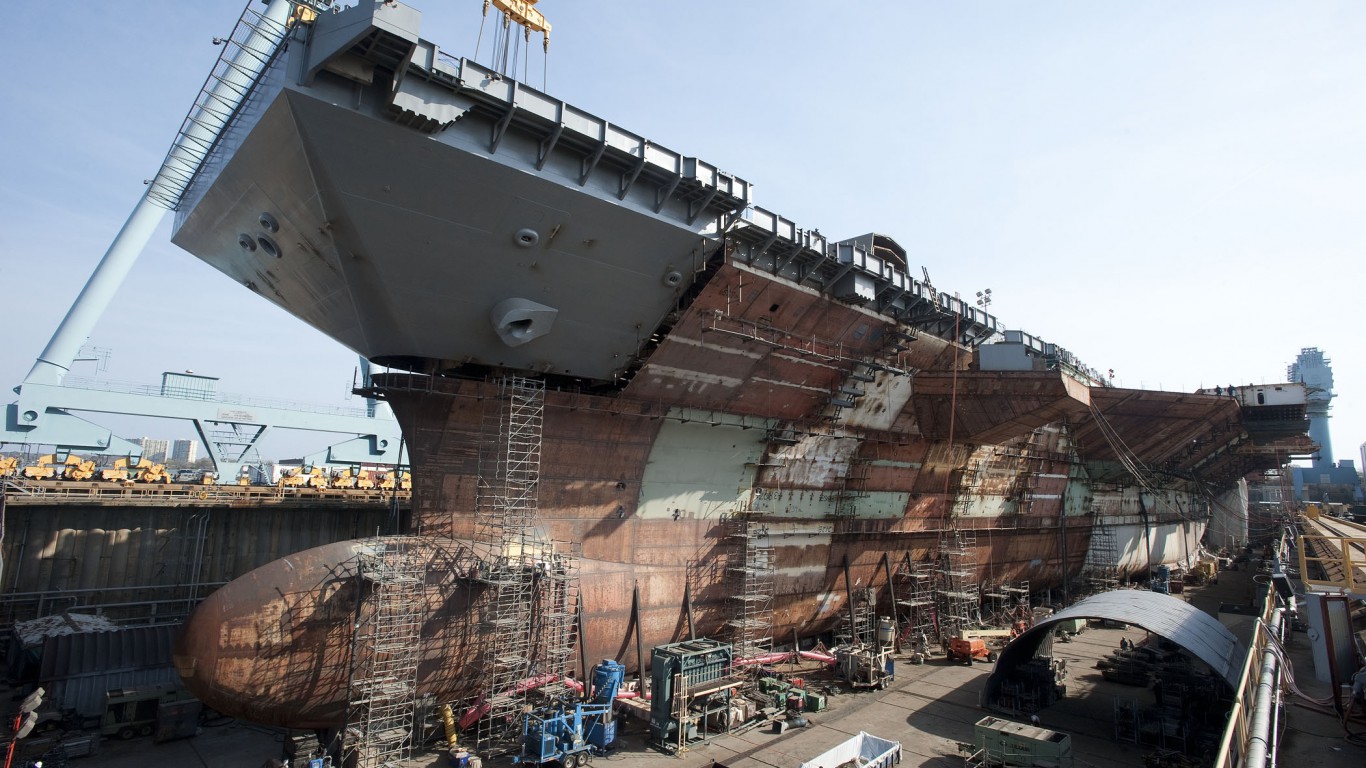
7. Huntington Ingalls Industries Inc. (NYSE: HII)
> 2017 funding obligations: $7.24 billion
> Market Cap: $9.51 billion
> Total Revenue: $7.44 billion
> Net Income: $479.00 million
> Shares outstanding: 44.79 million
> Employees: approximately 38,000
Huntington Ingalls builds the single most expensive and largest military weapon in the U.S. arsenal, the Gerald R. Ford-class aircraft carrier. The first of four new carriers on order, the Ford was commissioned last year after the company spent $13 billion to build the ship. The fiscal 2019 budget includes $4.5 billion for continuing work on the second and the third carriers that will be christened the John F. Kennedy and the Enterprise. A name has not been selected for the fourth. Eventually, the Ford-class carriers are expected to replace the Navy’s entire current Nimitz-class fleet of 11, guaranteeing Huntington Ingalls a solid decade or so of work. For the current fiscal year, analysts forecast revenue of $7.63 billion and have a 12-month consensus price target on the stock of $254.64.
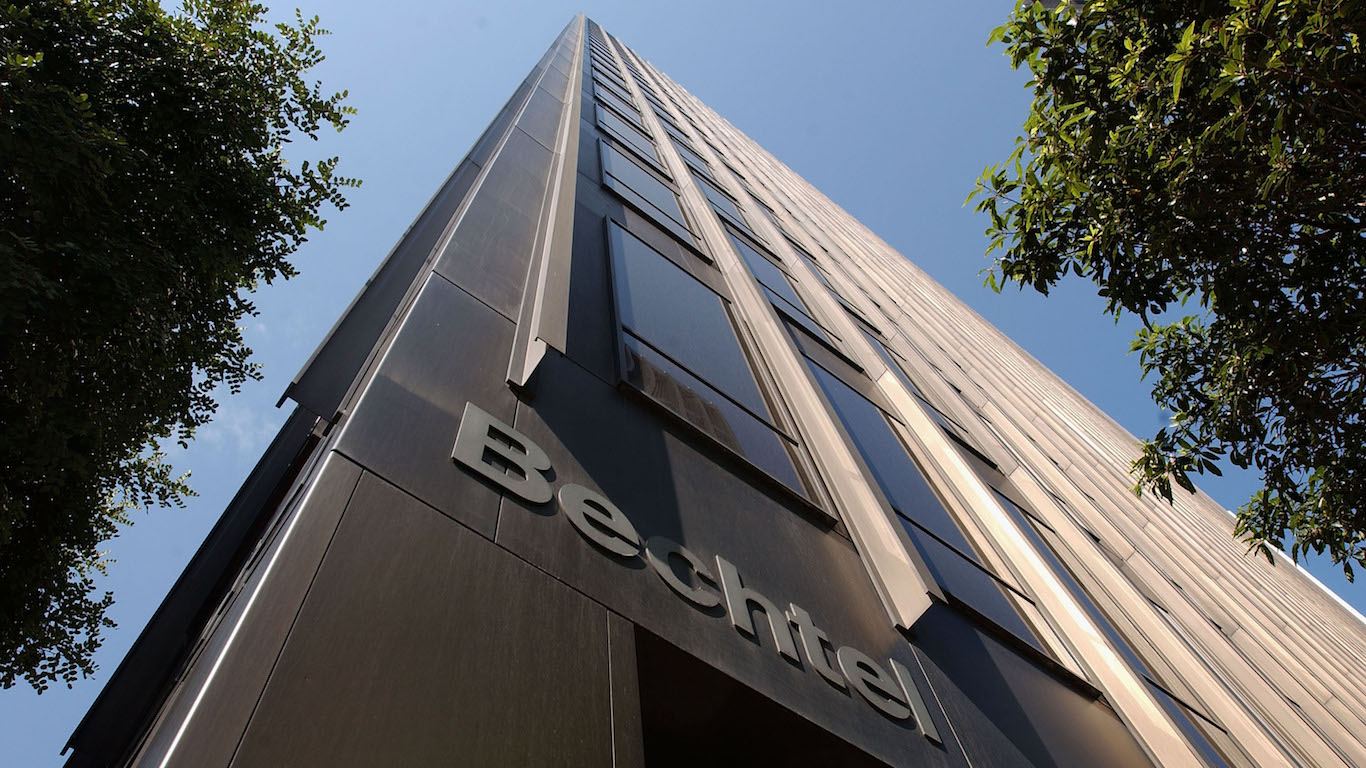
8. Bechtel Group Inc.
> 2017 funding obligations: $5.53 billion
> Market Cap: N/A
> Total Revenue: $32.90 billion (2016)
> Net Income: N/A
> Shares outstanding: N/A
> Employees: N/A
Bechtel, an engineering and construction firm, is the only privately held company on this list of top defense contractors. In 2015, the company’s largest federal contracts were valued at $2.48 billion with the U.S. Navy and $1.73 billion with the U.S. Department of Energy. Both were related to work on nuclear reactors. The company’s 10-year contract with the Navy, valued at a total of $12.8 billion, expires this year. On the non-military side, Bechtel has worked on two massive liquefied natural gas (LNG) liquefaction facilities: the Sabine Pass project offshore of Louisiana and the Wheatstone project offshore of Northwest Australia. No estimates for the company’s total revenue are available.
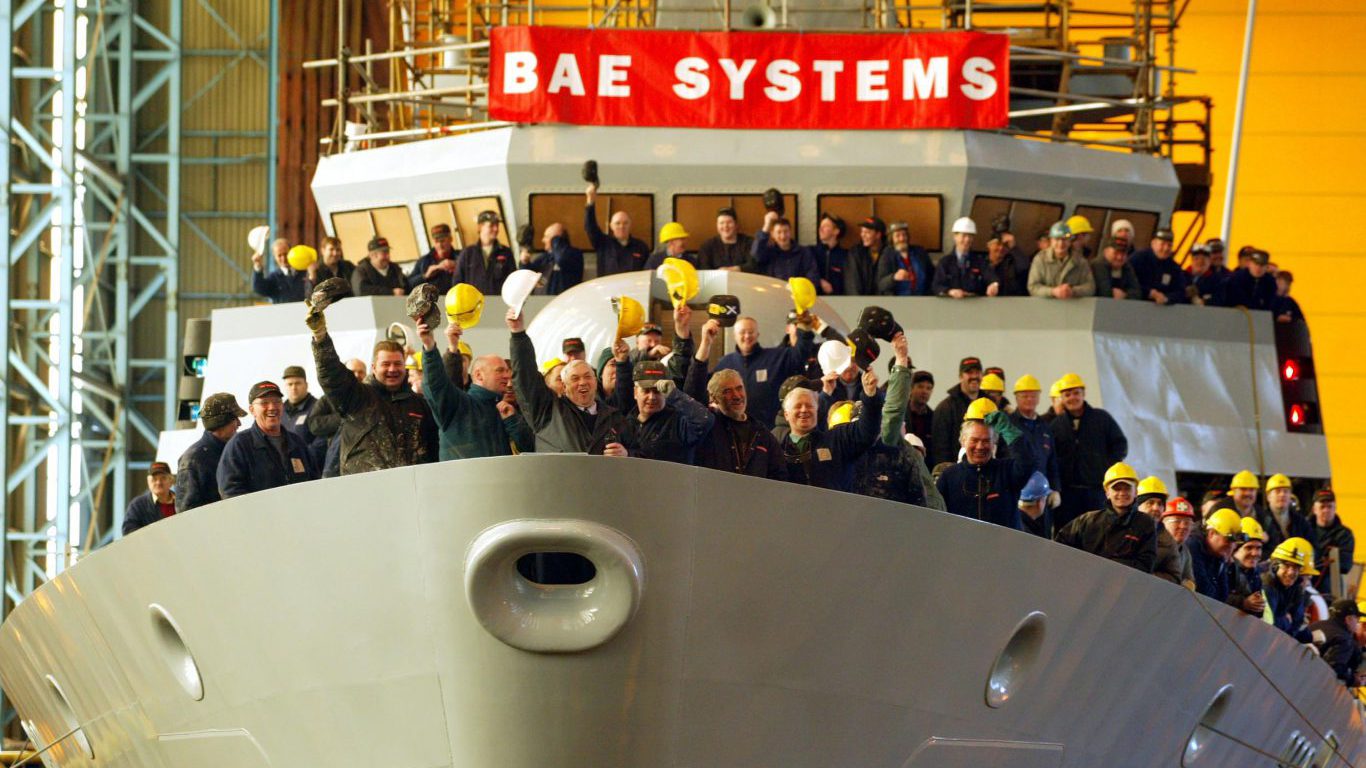
9. BAE Systems plc
> 2017 funding obligations: $5.29 billion
> Market Cap: £26.07 billion
> Total Revenue: £18.32 billion
> Net Income: £1.36 billion
> Shares outstanding: 3.19 billion
> Employees: 83,200
BAE is the only non-U.S.-based company among top federal contractors. The British company just won a $198 million contract from the U.S. Marine Corps to build an initial batch of 30 wheeled amphibious combat vehicles out of a planned total of 208. If all are built the contract will be worth about $6.2 billion to BAE, including $1.2 billion to manufacture the vehicles and $5 billion to maintain them over their expected lifespan. For the current fiscal year, analysts forecast revenue of £18.5 billion and have a 12-month consensus price target on the stock of £6.73 per share.
[in-text-ad-2]

10. L3 Technologies Inc. (NYSE: LLL)
> 2017 funding obligations: $5.15 billion
> Market Cap: $15.04 billion
> Total Revenue: $9.57 billion
> Net Income: $753.00 million
> Shares outstanding: 78.22 million
> Employees: approximately 31,000
L3 makes a wide range of electronic, sensor, and communications systems for military, homeland security, and commercial platforms. The company is also a prime contractor of aerospace systems, security and detection systems, and pilot training. Last year the company won a contract as the systems integrator to modernize the U.S. Air Force’s Compass Call EC-130H aircraft. Despite a Boeing protest, L3 chose General Dynamics’ Gulfstream 550 as the airplane that would carry the sophisticated Compass Call electronic warfare gear. No value for the contract has been released. For the current fiscal year, analysts forecast revenue of $9.99 billion and have a 12-month consensus price target on the stock of $236.93.
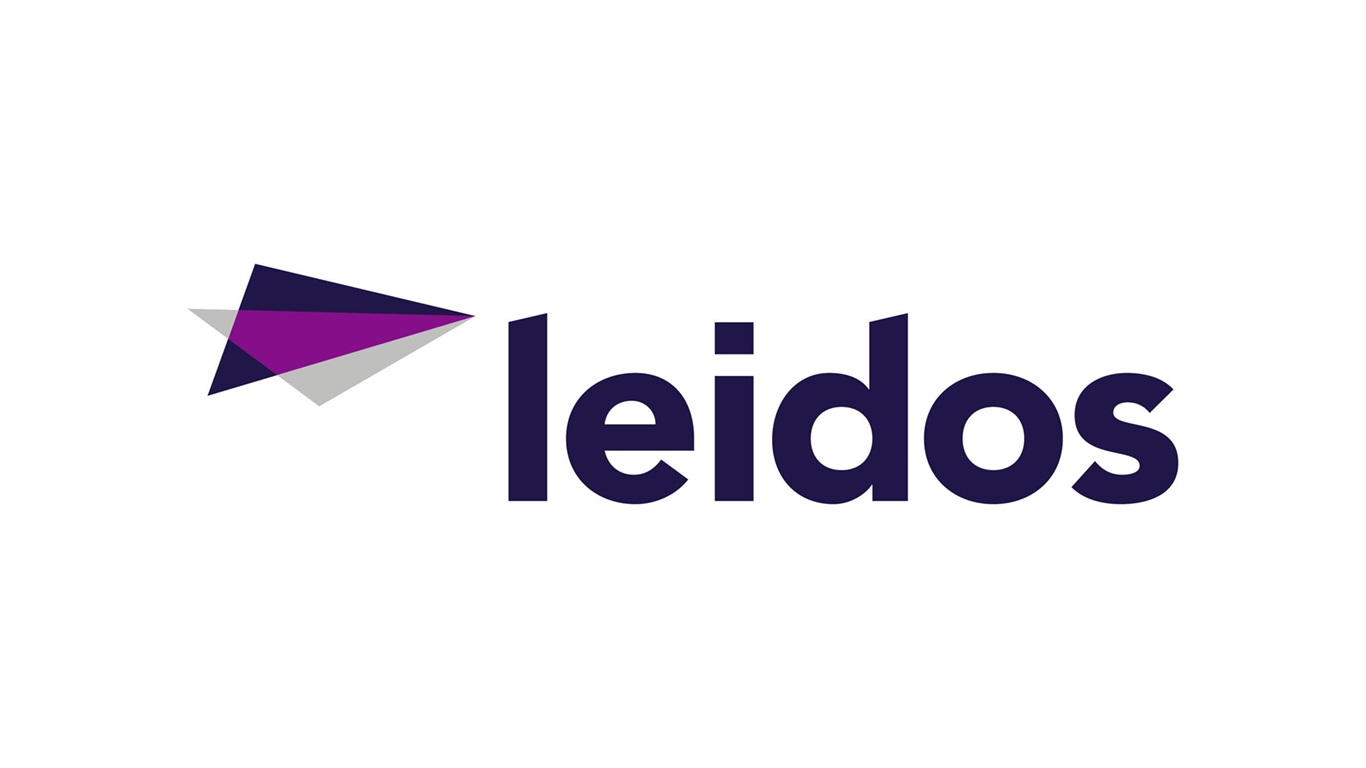
11. Leidos Holdings Inc. (NYSE: LDOS)
> 2017 funding obligations: $4.79 billion
> Market Cap: $8.86 billion
> Total Revenue: $10.17 billion
> Net Income: $366.00 million
> Shares outstanding: 151.46 million
> Employees: approximately 31,000
Leidos’ defense solutions group generated nearly half of the company’s 2017 revenue, but U.S. government contracts accounted for 84% of 2017’s total company revenue. In addition to a variety of security and intelligence systems, Leidos recently bested Raytheon in a competition to build a hosted payload for the Federal Aviation Administration’s Galaxy-30 satellite that will sharpen GPS signals. The company is currently battling Amazon, Google, and other technology and defense firms for a Pentagon cloud contract worth as much as $10 billion. The winner of the Joint Enterprise Defense Infrastructure (JEDI) will create and manage a cloud-based application the military will use to host and distribute mission-critical workloads and classified secrets all over the world. For the current fiscal year, analysts forecast revenue of $10.4 billion and have a 12-month consensus price target on the stock of $77.20.
[in-text-ad]

12. Aecom (NYSE: ACM)
> 2017 funding obligations: $4.11 billion
> Market Cap: $5.39 billion
> Total Revenue: $18.20 billion
> Net Income: $339 million
> Shares outstanding: 157.62 million
> Employees: 87,000
Like Bechtel, Aecom is an engineering and construction company with a solid, although not dominant, presence in the federal contract world. One of its current showcase projects is a new Mercedes-Benz Stadium in Atlanta that seats up to 83,000 people for NFL and MLS games. For the U.S. government Aecom provides management services programs and facilities, none of which it discusses in any detail. In May, a wholly owned subsidiary won a $3.1 billion cost-plus-award-fee, 15-year contract with the U.S. Air Force for the operation, maintenance, and sustainment of test and training ranges in California, Utah, Nevada, and Colorado. For the current fiscal year, analysts forecast revenue of $19.67 billion and have a 12-month consensus price target on the stock of $40.54.

13. Booz Allen Hamilton Holding Corp. (NYSE: BAH)
> 2017 funding obligations: $4.09 billion
> Market Cap: $6.42 billion
> Total Revenue: $6.17 billion
> Net Income: $$305.11 million
> Shares outstanding: 5.29 billion
> Employees: approximately 24,600
Booz Allen provides a variety of management and technology consulting services to governments, corporations, and nonprofits worldwide. The company began working with the U.S. Navy in 1940, and the Navy remains its largest client. Work for the Defense Department accounted for 46% of its fiscal year revenue. Booz Allen also provides mission-critical support for the International Space Station and assists commercial and government clients with cyber threats. At least one incident the company would like to forget is its hiring of NSA documents leaker Edward Snowden as a contractor in 2013. For the current fiscal year, analysts forecast revenue of $6.6 billion and have a 12-month consensus price target on the stock of $49.10.

14. Humana Inc.
> 2017 funding obligations: $3.72 billion
> Market Cap: $41.18 billion
> Total Revenue: $53.77 billion
> Net Income: $2.45 billion
> Shares outstanding: 137.68 million
> Employees: approximately 45,900
Humana is one of the country’s largest health insurers, and the company offers administrative services to the Department of Defense through its Tricare program. Beginning in 2016, the company began providing services to about 6 million program beneficiaries in 32 states, with delivery of health care services beginning in January of this year. The five-year contract expires at the end of 2022 and may be renewed at the government’s option. Humana reported military enrollment totaling nearly 3.1 million at the end of 2017. For the current fiscal year, analysts forecast revenue of $56.29 billion and have a 12-month consensus price target on the stock of $316.44.
[in-text-ad-2]
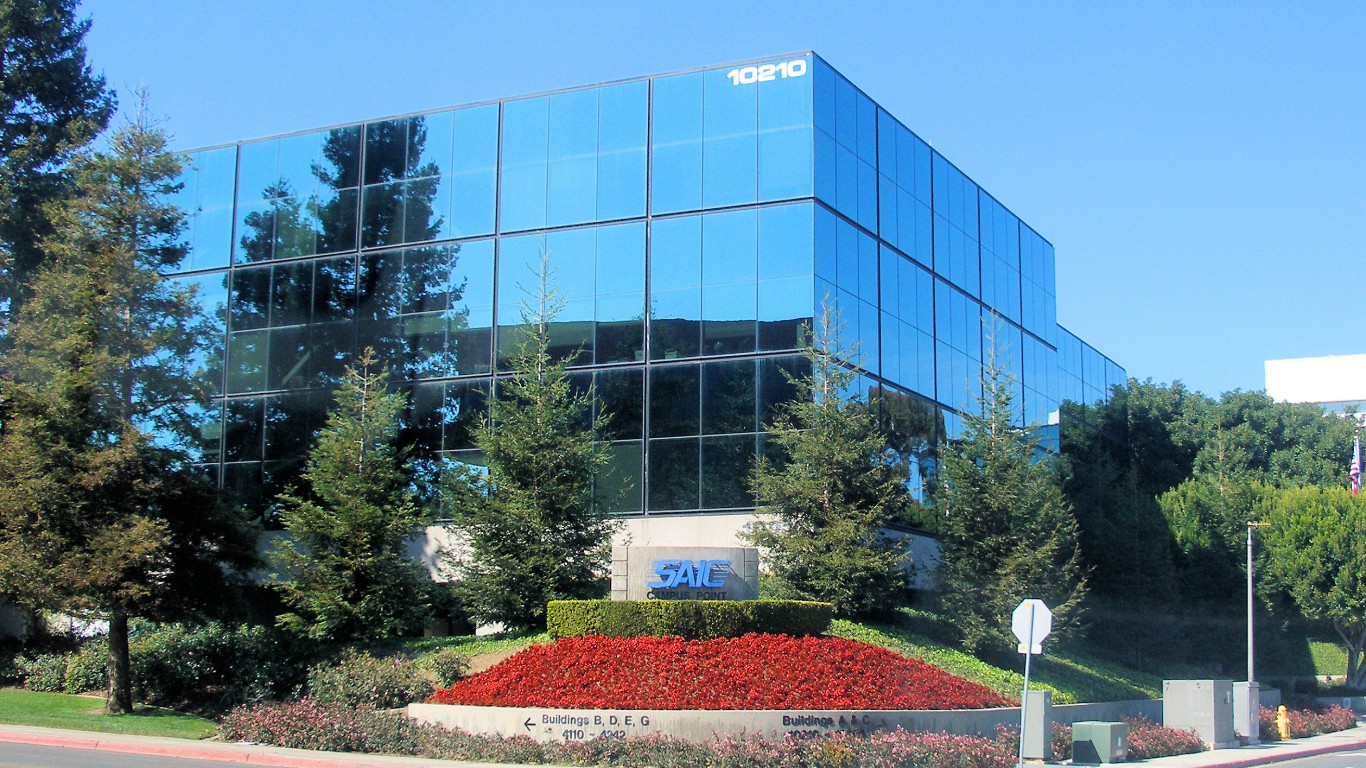
15. Science Applications International Corp. (NYSE: SAIC)
> 2017 funding obligations: $3.46 billion
> Market Cap: $3.45 billion
> Total Revenue: $4.45 billion
> Net Income: $179.00 million
> Shares outstanding: 42.28 million
> Employees: more than 15,000
SAIC is a pure-play technical services provider to the U.S. government and is the prime contractor of 91% of what the company calls “premier” contract vehicles. These are basically open-ended federal contracts that allow prime contractors to collect a fee for matching a vendor with a government agency. SAIC lists 14 federal contract vehicles under its management, including one to provide advice and assistance to the Army’s Aviation and Missile Command and another to provide IT solutions to the Department of Homeland Security. Even though SAIC lost the bidding for a Marine Corps amphibious combat vehicle to BAE this month, last November the company won a one-year, $980 million Army battlefield systems contract that is renewable for two additional years. For the current fiscal year, analysts forecast revenue of $56.29 billion and have a 12-month consensus price target on the stock of $89.67.
100 Million Americans Are Missing This Crucial Retirement Tool
The thought of burdening your family with a financial disaster is most Americans’ nightmare. However, recent studies show that over 100 million Americans still don’t have proper life insurance in the event they pass away.
Life insurance can bring peace of mind – ensuring your loved ones are safeguarded against unforeseen expenses and debts. With premiums often lower than expected and a variety of plans tailored to different life stages and health conditions, securing a policy is more accessible than ever.
A quick, no-obligation quote can provide valuable insight into what’s available and what might best suit your family’s needs. Life insurance is a simple step you can take today to help secure peace of mind for your loved ones tomorrow.
Click here to learn how to get a quote in just a few minutes.
Thank you for reading! Have some feedback for us?
Contact the 24/7 Wall St. editorial team.
 24/7 Wall St.
24/7 Wall St. 24/7 Wall St.
24/7 Wall St. 24/7 Wall St.
24/7 Wall St.


